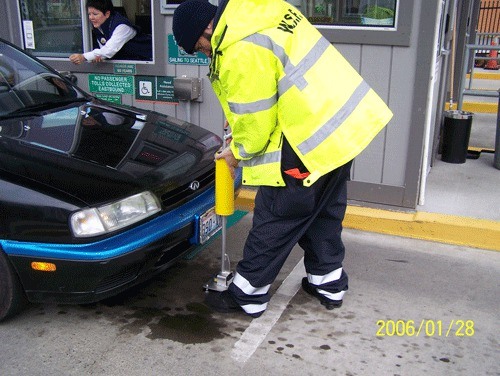Have no fear. The lasers are here.
Washington State Ferries is going high-tech, swapping measuring tape for laser-equipped devices, as it embarks on a new era of ticket pricing.
WSF Director of Operations Steve Rogers acknowledges that Ferries found a few flies in the ointment when tickets began to be bought and sold for the new 14-foot-and-under category of vehicles. The 14-foot-or-less category became effective in October, along with a 2.5 percent fare increase, as did an extension of two feet on the standard vehicle category, which now measures up to 22 feet.
“I have to admit in the beginning we had a few difficulties to work out,” he said. “I think we have things moving pretty smoothly now.”
Rogers said that tape measures could prove imprecise in cases where it came down to inches, and the length of different auto models and brands may change from year to year. He added that owners’ manuals generally measure a vehicle’s length in inches while Ferries calculates it ticket prices in feet.
What Ferries found, Rogers said, was it needed more precision pumped into the system in order to clear up some of the confusion.
According to Customer Service Manager Susan Harris, WSF has refunded roughly 400 tickets to people — systemwide — who bought a 14-foot or under fare and then later found out that they’re vehicle failed to measure up. About 25 to 30 of those refunds went to those who bought a ticket for a San Juan sailing, Harris said.
“We’re talking about vehicles under 168 inches,” Harris said. “When you say 14 feet that sounds pretty big. But when you say it as 168 inches, it doesn’t sound quite as large. I think that’s one of the reasons that people initially were confused.”
The solution? Apparently two-fold.
Rogers said a portable “laser-measuring device” was designed in-house by WSF engineers at the agency’s maintenance facility in Eagle Harbor. The devices have been deployed to “measuring stations” throughout the system, including the Anacortes terminal, and he expects that the measuring process, if needed, will be more efficient and precise.
Then, there’s also a 14-foot-or-under sticker for your windshield. Have your vehicle measured by WSF and then receive a decal signifying which category your car belongs in and that can be displayed on the interior of your windshield. Rogers said Ferries “encourages” use of the sticker as a way to avoid delay or confusion at the ticket booth.
Harris encourages early arrival at the ferry terminal for those thinking or needing to have a vehicle measured, or schedule an appointment. In Anacortes, notify a ticket booth operator if you wish to have your vehicle measured. A list of pre-approved 14-foot makes and models also can be found on Washington State Ferries website.
Ferries spring sailing schedule goes into (went into) effect Sunday, March 25. It marks the third change in the Anacortes/San Juan sailing schedule with the 14-foot category in place. The cost of a car-and-driver 14-foot fare, from Anacortes to Friday Harbor, is $41.25. The price of 14-foot or less is $37.15.
For more info about fares; visit, www.wsdot.wa.gov/ferries/fares/




